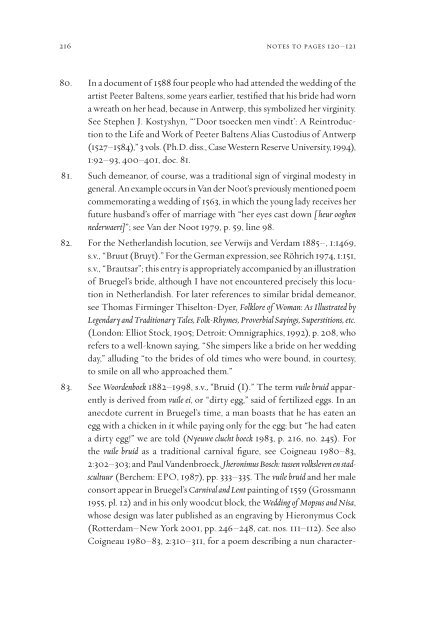Pieter Bruegel and the Art of Laughter - AAAARG.ORG
Pieter Bruegel and the Art of Laughter - AAAARG.ORG
Pieter Bruegel and the Art of Laughter - AAAARG.ORG
Create successful ePaper yourself
Turn your PDF publications into a flip-book with our unique Google optimized e-Paper software.
216 notes to pages 120–121<br />
80. In a document <strong>of</strong> 1588 four people who had attended <strong>the</strong> wedding <strong>of</strong> <strong>the</strong><br />
artist Peeter Baltens, some years earlier, testified that his bride had worn<br />
a wreath on her head, because in Antwerp, this symbolized her virginity.<br />
See Stephen J. Kostyshyn, “‘Door tsoecken men vindt’: A Reintroduction<br />
to <strong>the</strong> Life <strong>and</strong> Work <strong>of</strong> Peeter Baltens Alias Custodius <strong>of</strong> Antwerp<br />
(1527–1584),” 3 vols. (Ph.D. diss., Case Western Reserve University, 1994),<br />
1:92–93, 400–401, doc. 81.<br />
81. Such demeanor, <strong>of</strong> course, was a traditional sign <strong>of</strong> virginal modesty in<br />
general. An example occurs in Van der Noot’s previously mentioned poem<br />
commemorating a wedding <strong>of</strong> 1563, in which <strong>the</strong> young lady receives her<br />
future husb<strong>and</strong>’s oªer <strong>of</strong> marriage with “her eyes cast down [ heur ooghen<br />
nederwaert]”; see Van der Noot 1979, p. 59, line 98.<br />
82. For <strong>the</strong> Ne<strong>the</strong>rl<strong>and</strong>ish locution, see Verwijs <strong>and</strong> Verdam 1885–, 1:1469,<br />
s.v., “Bruut (Bruyt).” For <strong>the</strong> German expression, see Röhrich 1974, 1:151,<br />
s.v., “Brautsar”; this entry is appropriately accompanied by an illustration<br />
<strong>of</strong> <strong>Bruegel</strong>’s bride, although I have not encountered precisely this locution<br />
in Ne<strong>the</strong>rl<strong>and</strong>ish. For later references to similar bridal demeanor,<br />
see Thomas Firminger Thiselton-Dyer, Folklore <strong>of</strong> Woman: As Illustrated by<br />
Legendary <strong>and</strong> Traditionary Tales, Folk-Rhymes, Proverbial Sayings, Superstitions, etc.<br />
(London: Elliot Stock, 1905; Detroit: Omnigraphics, 1992), p. 208, who<br />
refers to a well-known saying, “She simpers like a bride on her wedding<br />
day,” alluding “to <strong>the</strong> brides <strong>of</strong> old times who were bound, in courtesy,<br />
to smile on all who approached <strong>the</strong>m.”<br />
83. See Woordenboek 1882–1998, s.v., “Bruid (I).” The term vuile bruid apparently<br />
is derived from vuile ei, or “dirty egg,” said <strong>of</strong> fertilized eggs. In an<br />
anecdote current in <strong>Bruegel</strong>’s time, a man boasts that he has eaten an<br />
egg with a chicken in it while paying only for <strong>the</strong> egg: but “he had eaten<br />
a dirty egg!” we are told (Nyeuwe clucht boeck 1983, p. 216, no. 245). For<br />
<strong>the</strong> vuile bruid as a traditional carnival figure, see Coigneau 1980–83,<br />
2:302–303; <strong>and</strong> Paul V<strong>and</strong>enbroeck, Jheronimus Bosch: tussen volksleven en stadscultuur<br />
(Berchem: EPO, 1987), pp. 333–335. The vuile bruid <strong>and</strong> her male<br />
consort appear in <strong>Bruegel</strong>’s Carnival <strong>and</strong> Lent painting <strong>of</strong> 1559 (Grossmann<br />
1955, pl. 12) <strong>and</strong> in his only woodcut block, <strong>the</strong> Wedding <strong>of</strong> Mopsus <strong>and</strong> Nisa,<br />
whose design was later published as an engraving by Hieronymus Cock<br />
(Rotterdam–New York 2001, pp. 246–248, cat. nos. 111–112). See also<br />
Coigneau 1980–83, 2:310–311, for a poem describing a nun character-












